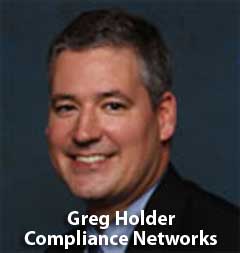SCDigest editor Dan Gilmore recently sat down with Greg Holder, CEO of Compliance Networks, to discuss various aspects of retail vendor performance management. Part 1 of this interview ran in the July issue of the Retail Vendor Performance Management Bulletin. Below is Part 2.
Gilmore: How would you rate the level of visibility most retailers have today to the full PO Lifecycle?
Compliance Networks Says... |
 |
| The Wall Street Journal recently highlighted how many retailers are developing a "less is more" approach to inventory, and visibility is a big part of that. |
 |
|
|
Holder: Honestly, I see few retailers that have visibility to their overall PO Lifecycle due to the challenges they have aggregating data from their source execution systems. I think this will put them at a disadvantage going forward, as we clearly seea trend emerging to reduce inventory costs while simultaneously increasing service levels.
Recall our view of the PO Lifecycle is that it is from PO creation through consumption either at a retail DC, a retail store and now also a vendor drop ship.
The different data elements of the PO Lifecycle include PO create and approve, EDI send, PO start and stop ship, and PO cancel date. Those are all contained within the PO itself but there are still many others outside of the PO data set. These include routing request date, ready to ship date, approved routing date, ship date, arrive on yard date, unload date, received date, ASN send date, and ASN receive date.
All of the data elements should be tracked for each shipment. Other considerations are how to handle problem POs, for which there are dates to identify issues and if they have been resolved.
Visit the Retail Vendor Performance Management home page to learn more
and subscribe to the monthly newsletter.
Gilmore: Do those retailers that have poor visibility just not get the benefits that visibility can bring, or is it just that they don’t have the right tools.
 Holder: It is a little bit of both. If retailers do not understand the benefit of visibility, they are ignoring strategies that are being deployed by high performing retailers. The Wall Street Journal recently highlighted how many retailers are developing a "less is more" approach to inventory, and visibility is a big part of that. But many software providers bring only one component of visibility to the table. For example, WMS companies bring visibility to the four walls of the DC, TMS companies bring inbound/outbound transportation visibility, etc. There are few solutions that are able to bring all of the data into one place across the full retail PO Lifecycle. Holder: It is a little bit of both. If retailers do not understand the benefit of visibility, they are ignoring strategies that are being deployed by high performing retailers. The Wall Street Journal recently highlighted how many retailers are developing a "less is more" approach to inventory, and visibility is a big part of that. But many software providers bring only one component of visibility to the table. For example, WMS companies bring visibility to the four walls of the DC, TMS companies bring inbound/outbound transportation visibility, etc. There are few solutions that are able to bring all of the data into one place across the full retail PO Lifecycle.
For those retailers trying to do it themselves, I think the complexity becomes overwhelming to them and they most likely rarely get beyond phase 1 of a visibility project. As a former practitioner myself, I have lived it and can tell you it’s much more challenging than assembling additional pivot tables.
Gilmore: How does a retail compliance program support visibility?
Holder: Ten million dollar question. From my perspective, some years back, I missed the value of what we, Compliance Networks, were trying to do. We set out to help retailers automate what is typically a manual vendor compliance process. We were thinking it would be great because our customers could save some payroll expense, increase charge identification by automating a manual process, and ultimately remove days from the inbound supply chain by eliminating a lot of the disruptions.
In order to automate supply chain failures we needed tools to gather supply chain transactions from retailer and supplier execution systems, such PO systems, WMS, etc.
With this data we could create sophisticated algorithms to interrogate the data and identify exceptions or violations to a retailer’s requirements. What I did not understand at the time was the value of the supply chain data in terms of visibility to things like vendor performance and profitability, supply chain days, carrier performance, DC performance and even merchandising performance.
Gilmore: You have built a visibility solution on top of your existing compliance management solution - tell us a bit about that.
Holder: Over the years, as we have continued to add more data from different data silos we realize we have a pretty good picture of the retail supply chain. By layering in various information structures we end up with an environment for centralized access at various reporting levels for not only the vendor but for merchants, ship points and destinations, retailer department organizations, order types, etc.
The list goes on and on and it is not just at a single structure but also any combination of multiple structures down to the item level, if we need to go that deep. It is really an exciting thing. We see the PO Lifecycle transitioning from a "nice to have" to a critical component of a retailer’s overall merchandise plan execution strategy.
Any comments on this article? Please send below.
Your Comments/Feedback
|